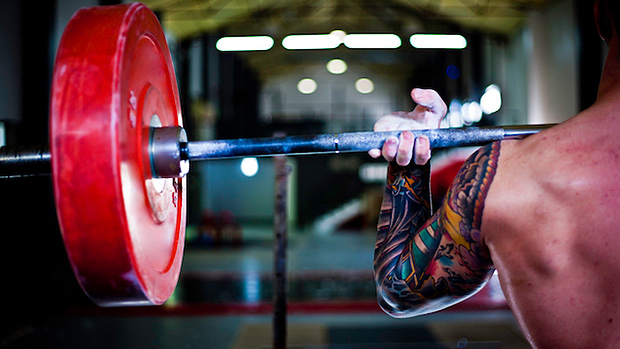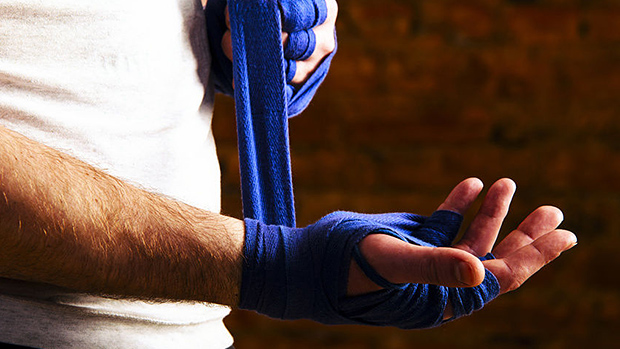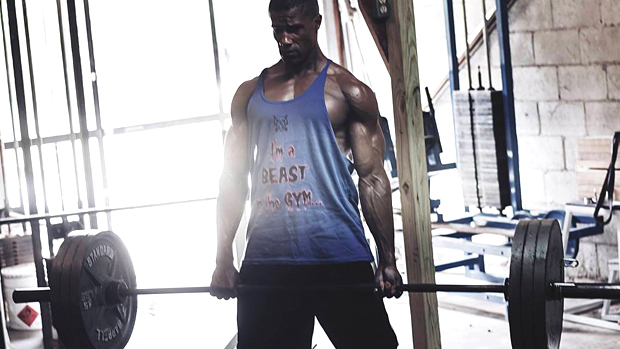Why does a person decide to lift weights? No doubt for one or more of the following reasons:
- To gain muscle mass
- To gain strength
- To improve one's sports performance
- To rehabilitate an injury
- To get leaner
- To improve one's health
- To get out of the house and away from a nagging significant other
- To improve one's chances of getting lucky with a prospective new significant other
All valid reasons, but I'll bet that the first on the list is the first on most people's list. Everyone wants more muscle, even if they won't admit it, or even realize it. Even the chick who says, "I don't want big muscles, I just want to get, like, more toned" will need to grow muscle in order to accomplish her goal.
Lifting weights improves your appearance precisely because it causes muscular growth. From looking trim, hard, and defined, to looking downright freaky hyuuuuge, you need to grow muscle to attain what you want from training.
So we can all agree that muscular growth is a good thing (we all should, anyway). The problem is that not everyone agrees on how best to stimulate this growth. This can get confusing.
A lot of big guys will tell you that heavy lifting is the only way to go: "Just shut up and lift the damn bar," they grunt. "Then add more weight and lift it again! That pumping stuff is for pussies!"
Other guys (many just as big) will tell you that the key is constant muscular tension: simply lifting the weight isn't enough: you must aim for the quality of the contraction, squeezing the muscle as hard as you can every rep.
Then there are the guys (who also have some impressive physiques) who insist that you should focus on volume: most top bodybuilders lift in the moderate rep ranges, they rightly point out, so you too should leave the super heavy weights for the powerlifters.
So who's right? Well, there's the rub. They all are, to some extent.
You can't argue with results. Guys have been getting big by focusing on lifting huge weights on a few basic exercises. Others built their mass by doing a lot of physical work on several exercises with a moderate resistance. Some built great physiques by ''just lifting the damn weight'', while others really emphasize the squeeze, the pump and feeling the muscle. It's hard to say that any of these methods "don't work", because we can find thousands of people for whom they do work, big time.
So we have three basic methods of growing muscle: heavy lifting, constant tension, and volume. We know that all three of these methods work, because we can see the results. In order to use these methods to optimize our workouts, let's look at each one in turn, to find out how and why they work.
Lifting a heavy weight makes your muscles grow primarily by causing damage to the muscle fibers at the cellular level. This is called microtrauma, and it involves a high rate of protein degradation caused by the high output of force exerted by the muscle tissue.
Other factors are neural (more complete recruitment and fatigue of the high-threshold motor units) and hormonal (an increase of free testosterone). These factors become especially true when the weight progressively increases, because it forces the muscles to increase their size and strength in order to adapt to an increasing physical demand.
Heavy lifting also kick-starts your nervous system, recruiting more high-threshold motor units in the following sets, and making every other exercise in your workout more effective. Finally, heavy lifting increases muscle density and myogenic tone, which allows the muscle to look hard even at rest.
You don't need to lift your one rep max, or shoot for singles or doubles to have the benefits of heavy lifting. If anything, when training for hypertrophy it's best to keep lifting heavy, but keep the reps moderate.
Beginners and intermediate lifters will get good results lifting around 85% of their maximum, lifting in the 6 to 8 rep range to failure, while more advanced trainees will need to go up to 90%, lifting in the 3 to 5 rep range. Advanced lifters can also use high-intensity techniques such as cluster sets (sets of 5 reps with 90-92% of your max, taking 10 sec.) and rest-pause (perform a 3 to 5 rep max, rest for 10-12 seconds, then do a few more reps).
Here the muscle is kept at maximum tension throughout the duration of the exercise. You can't allow the muscle to relax for even a fraction of a second during the rep: the moment the muscle is allowed to relax, the set loses its efficacy. Constant tension sets need to be performed with relatively light weights, because maintaining maximum muscle tension over the entire range of motion of every rep of a heavy set is, quite frankly, hard as hell.
Although the light weights don't cause much in the way of muscle trauma, studies have shown that this type of training is very effective for building both strength and size. This indicates that there is another pathway for stimulating hypertrophy: blood occlusion.
Constant muscle tension closes off the blood vessels leading to the muscles, temporarily depriving the muscles of oxygen throughout the duration of the exercise. This stimulates an increase of lactate production, as well as hGH and IGF-1, two anabolic hormones. Studies also indicate that stimulating a muscle in a hypoxic (oxygen-deprived) state cranks up fast-twitch fiber activation, probably because the aerobic pathway, on which slow-twitch fibers depend, has been temporarily shut down.
Sets using this method should last at least 30 seconds, although I prefer 40 to 70 second sets to maximize lactate production. The tempo should be relatively slow (but not super slow), and as I mentioned, the weight should be relatively light. Isolation movements work best with this method.
I can't emphasize enough that the target muscle must never be allowed to relax during the set. If you allow the muscle to relax, even for a moment, oxygen will enter the muscle and you'll be wasting your time. So just grit your teeth and keep that muscle flexed, with no pause between reps.
Vladimir Zatsiorsky wrote, "to be stimulated into growing, a muscle fiber must not only be recruited, but also exhausted." Although heavy lifting is a fantastic tool for growth, it often leaves some fibers un-stimulated. Volume work, especially when performed with shorter rest intervals, can increase the number of muscle fibers being stimulated via the cumulative fatigue effect. Sure, this leads to mostly slow-twitch fiber hypertrophy, but if you're only after maximum muscle growth, who cares?
Of course, athletes should focus solely on fast-twitch fiber development, but mass-minded individuals don't need to shy away from volume work. Hell, even the Westside guys are known to do high-volume training from time to time, with very high reps.
This method works best with 8 to 12 reps (15 to 20 reps for some exercises), with short rest intervals of 45 to 60 seconds. Advanced lifters can also use high-density techniques such as pre/post-fatigue (superset of two exercises for the same muscle group), drop-sets (perform 8-12 reps to technical failure, drop the weight by 15-20% and continue to perform reps), and double contractions (one-and-one half reps).
A rule of thumb for exercise selection is: put the most CNS-demanding movements early in the workout. Heavier and more complex movements place more demand on the nervous system, so a workout using all three hypertrophy methods would use this order:
- Heavy movements using big compound exercises such as bench press, squat, Romanian deadlift, military press, and rows
- Intermediate movements such as dumbbell press, leg press, lunges, reverse hyper, glute-ham raise, and wide stance leg press, for sets in the 8 to 12 rep range
- Isolation exercise using constant tension for sets lasting 40 to 70 seconds (12 to 15 slow, tensed reps)
Another important rule is: the fewer reps per set, the more sets you should do.
Below is a list of exercises and set/rep/interval arrangements for each bodypart, which will help you use the three methods we've talked about. Note that these are only examples; other movements can be substituted.
Beginner
| Exercise | Sets | Reps | Rest | |
|---|---|---|---|---|
| A | Decline bench press | 5-6 | 6-8 | 2 min. |
| B | Incline dumbbell press | 4-5 | 10-12 | 90 sec. |
| C | Cable cross-over constant tension | 3-4 | 12-15 | 60 sec. |
Intermediate
| Exercise | Sets | Reps | Rest | |
|---|---|---|---|---|
| A | Decline bench press | 5-6 | 3-5 | 2 min. |
| B | Incline dumbbell press | 4-5 | 8-10 | 90 sec. |
| C | Cable cross-over constant tension | 3-4 | 10-12 | 60 sec. |
Advanced
| Exercise | Sets | Reps | Rest | |
|---|---|---|---|---|
| A | Decline bench press (sets of 5 reps with 10 sec. between reps) | 5-6 | 5x1 cluster | 2 min. |
| B1 | Flat dumbbell press | 4-5 | 8-10 | No rest |
| B2 | Flat dumbbell flies with a pronated grip | 4-5 | 8-10 | 90 sec. |
| C | Cable cross-over constant tension | 3-4 | 10-12 | 60 sec. |
Beginner
| Exercise | Sets | Reps | Rest | |
|---|---|---|---|---|
| A | Chest-supported dumbbell rowing or Chest-supported T-bar rowing with a parallel grip | 5-6 | 6 to 8 | 2 min. |
| B | Lat pulldown | 4-5 | 10-12 | 90 sec. |
| C | Bent-over dumbbell laterals | 4-5 | 10-12 | 90 sec. |
| D | Straight-arms pulldown constant tension | 3-4 | 12-15 | 60 sec. |
* Note that we do one more back exercise so that we can work on both lats and mid back equally.
Intermediate
| Exercise | Sets | Reps | Rest | |
|---|---|---|---|---|
| A | Chest-supported dumbbell rowing or Chest-supported T-bar rowing with a parallel grip | 5-6 | 3-5 | 2 min. |
| B | Lat pulldown | 4-5 | 8-10 | 90 sec. |
| C | Bent-over dumbbell laterals | 4-5 | 8-10 | 90 sec. |
| D | Straight-arms pulldown constant tension | 3-4 | 10-12 | 60 sec. |
Advanced
| Exercise | Sets | Reps | Rest | |
|---|---|---|---|---|
| A | Chest-supported dumbbell rowing or Chest-supported T-bar rowing with a parallel grip | 5-6 | 3-5 + rest-pause | 2 min. |
| B1 | Lat pulldown | 4-5 | 8-10 | no rest |
| B2 | Rope lat pulldown | 4-5 | 8-10 | 90 sec. |
| C | Seated rowing to abdomen with a pronated grip | 4-5 | 8-10 + drop set | 90 sec. |
| D | Straight-arms pulldown constant tension | 3-4 | 10-12 | 60 sec. |

Beginner
| Exercise | Sets | Reps | Rest | |
|---|---|---|---|---|
| A | Front squat | 5-6 | 6-8 | 2 min. |
| B | Close-stance leg press | 4-5 | 10-12 | 90 sec. |
| C | Leg extension constant tension | 3-4 | 12-15 | 60 sec. |
Intermediate
| Exercise | Sets | Reps | Rest | |
|---|---|---|---|---|
| A | Front squat | 5-6 | 3-5 | 2 min. |
| B | Close-stance leg press | 4-5 | 8-10 | 90 sec. |
| C | Leg extension constant tension | 3-4 | 10-12 | 60 sec. |
Advanced
| Exercise | Sets | Reps | Rest | |
|---|---|---|---|---|
| A | Front squat | 5-6 | 3-5 + rest-pause | 2 min. |
| B1 | Close-stance leg press | 4-5 | 8-10 | no rest |
| B2 | dumbbell squat | 4-5 | 8-10 | 90 sec. |
| C | Leg extension constant tension | 3-4 | 10-12 | 60 sec. |
Beginner
| Exercise | Sets | Reps | Rest | |
|---|---|---|---|---|
| A | Romanian deadlift | 5-6 | 6-8 | 2 min. |
| B | Leg curl | 4-5 | 10-12 | 90 sec. |
| C | 3/4 Dumbbell Romanian deadlift constant tension (stop 3-4" short of lockout) | 3-4 | 12-15 | 60 sec. |
Intermediate
| Exercise | Sets | Reps | Rest | |
|---|---|---|---|---|
| A | Romanian deadlift | 5-6 | 3-5 | 2 min. |
| B | Leg curl | 4-5 | 8-10 | 90 sec. |
| C | 3/4 dumbbell Romanian deadlift constant tension (stop 3-4" short of lockout) | 3-4 | 10-12 | 60 sec. |
Advanced
| Exercise | Sets | Reps | Rest | |
|---|---|---|---|---|
| A | Romanian deadlift | 5-6 | 3-5 + rest-pause | 2 min. |
| B1 | Leg curl | 4-5 | 8-10 | no rest |
| B2 | Wide stance/feet high leg press | 4-5 | 8-10 | 90 sec. |
| C | 3/4 dumbbell Romanian deadlift constant tension (stop 3-4" short of lockout) | 3-4 | 10-12 | 60 sec. |
Beginner
| Exercise | Sets | Reps | Rest | |
|---|---|---|---|---|
| A | Military press | 5-6 | 6-8 | 2 min. |
| B | Neutral (hammer) grip seated dumbbell press | 4-5 | 10-12 | 90 sec. |
| C | 1-arm cable lateral raise constant tension | 3-4 | 12-15 | 60 sec. |
Intermediate
| Exercise | Sets | Reps | Rest | |
|---|---|---|---|---|
| A | Military press | 5-6 | 3-5 | 2 min. |
| B | Neutral (hammer) grip seated dumbbell press | 4-5 | 8-10 | 90 sec. |
| C | 1-arm cable lateral raise constant tension | 3-4 | 10-12 | 60 sec. |
Advanced
| Exercise | Sets | Reps | Rest | |
|---|---|---|---|---|
| A | Push press | 5-6 | 3-5 | 2 min. |
| B1 | Neutral (hammer) grip seated dumbbell press | 4-5 | 8-10 | no rest |
| B2 | Incline lateral raise | 4-5 | 8-10 | 90 sec. |
| C | 1-arm cable lateral raise constant tension | 3-4 | 10-12 | 60 sec. |

Beginner
| Exercise | Sets | Reps | Rest | |
|---|---|---|---|---|
| A | Preacher curl (close grip) | 5-6 | 6-8 | 2 min. |
| B | Incline dumbbell curl | 4-5 | 10-12 | 90 sec. |
| C | Low-pulley cable curl constant tension | 3-4 | 12-15 | 60 sec. |
Intermediate
| Exercise | Sets | Reps | Rest | |
|---|---|---|---|---|
| A | Preacher curl (close grip) | 5-6 | 3-5 | 2 min. |
| B | Incline dumbbell curl | 4-5 | 8-10 | 90 sec. |
| C | Low-pulley cable curl constant tension | 3-4 | 10-12 | 60 sec. |
Advanced
| Exercise | Sets | Reps | Rest | |
|---|---|---|---|---|
| A | Preacher curl (close grip) | 5-6 | 3-5 + rest-pause | 2 min. |
| B | Incline dumbbell curl | 4-5 | 8-10 + drop set | 90 sec. |
| C | Low-pulley cable curl constant tension | 3-4 | 10-12 | 60 sec. |
Beginner
| Exercise | Sets | Reps | Rest | |
|---|---|---|---|---|
| A | Close-grip bench press | 5-6 | 6-8 | 2 min. |
| B | Decline dumbbell triceps extension | 4-5 | 10-12 | 90 sec. |
| C | Rope cable pressdown constant tension | 3-4 | 12-15 | 60 sec. |
Intermediate
| Exercise | Sets | Reps | Rest | |
|---|---|---|---|---|
| A | Close-grip bench press | 5-6 | 3-5 | 2 min. |
| B | Decline dumbbell triceps extension | 4-5 | 8-10 | 90 sec. |
| C | Rope cable pressdown constant tension | 3-4 | 10-12 | 60 sec. |
Advanced
| Exercise | Sets | Reps | Rest | |
|---|---|---|---|---|
| A | Close-grip bench press | 5-6 | 5x1 clusters | 2 min. |
| B | Decline dumbbell triceps extension | 4-5 | 8-10 + drop set | 90 sec. |
| C | Rope cable pressdown constant tension | 3-4 | 10-12 | 60 sec. |
If you wanted to use all of the exercises listed above to build a routine, you could use a split like this one:
- Monday: chest & back
- Tuesday: quadriceps
- Wednesday: OFF
- Thursday: biceps & triceps
- Friday: OFF
- Saturday: hamstrings and deltoids
- Sunday: OFF
But don't just go running off to the gym right now to try out this "routine" without thinking things through. The exercises and split above are just examples. The point of this article is to illustrate how the three types of hypertrophy training can be used in a training session for each muscle group.
The more approaches to stimulating muscle growth you know, the better equipped you will be to get the results you're after. My hope is that you will consider how these three approaches – heavy lifting, constant tension, and volume – can work to help you accomplish your goal, and that you will design your own program accordingly. Check out my articles How to Design a Damn Good Program Part 1 and Part 2 to help get you started.





